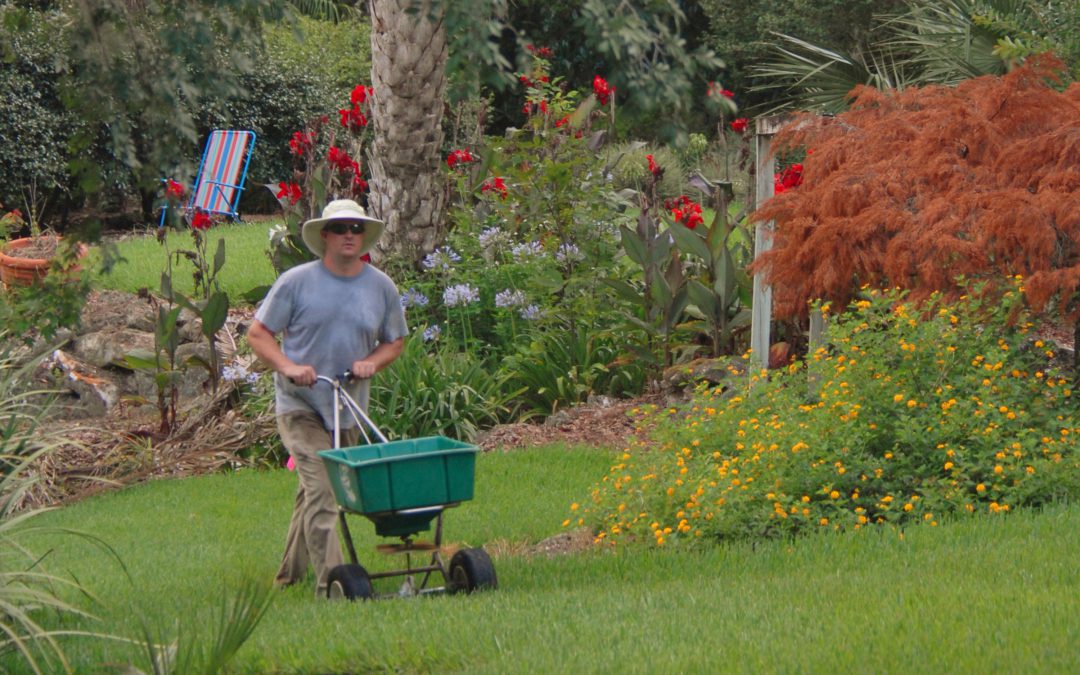
by Mark Tancig | Apr 30, 2020
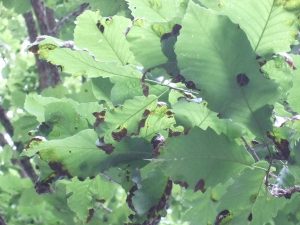
Symptoms of oak leaf blister on swamp chestnut oak. Credit: Gordon Magill.
Even during global pandemics, it’s a joy to be outside during the great north Florida spring we’ve been experiencing lately. As cold fronts come through with their rain bands, some packing a punch, they leave behind the most pleasant mornings, clear blue daytime skies, and crisp evenings. Unfortunately, we’re not the only organism that also enjoys those cool days. Many species of fungi are quite active this type of year as the rains, followed by warmer, yet not too hot temperatures, create the perfect conditions for fungal growth. Some of these fungi grow right on or in the plants we’d like to be enjoying for ourselves, stealing nutrients and causing plant decline or merely causing aesthetic damage. As this is an active time for certain species of fungi, local extension offices are getting more calls and questions regarding lawn and landscape damage due to fungal pathogens. A recent call was a new one for me and an example of a native fungi-plant interaction that looks bad but requires no intervention from us. It also highlights how correctly identifying a disease leads to the best action and can often save time and money and prevent unnecessary pesticides (in this case a fungicide) from entering the environment.

Close up of oak leaf blister on swamp chestnut oak. Credit: Gordon Magill.
The fungi and plant involved here was the oak leaf blister (Taphrina caerulescens) on a swamp chestnut oak (Quercus michauxii). It forms, you guessed it, blisters on the leaves of any of the oaks, though live oak (Quercus virginiana), laurel oak (Quercus laurifolia), and water oak (Quercus nigra) seem to be preferred hosts. The spores of the fungi, dormant since the previous summer/fall and which happen to get lodged in bud scales through wind and rain, germinate in cool, wet weather. The fungus then infects young leaves as they flush and its growth causes a disruption in the leaves’ development. This leads to the blistered look of the leaf tissue and, during extended periods of cool, wet weather, the entire leaf sort of shrivels, browns, and eventually falls off. Spores are eventually released from the fallen leaves to start the process over the next spring.

Severe oak leaf blister on swamp chestnut oak. Credit: Gordon Magill.
Though the leaves look pretty terrible, this fungal disease rarely causes plant health issues and the tree recovers just fine. Specimen trees that experience it year to year may be treated with a fungicide, but most homeowners can just let it go. Raking up and disposing of the leaves may help prevent further infections by reducing the number of spores released in the area.
As you enjoy another cool morning after an evening rainstorm, remember that the fungi all around you are also having a great day. You may want to look at your landscape plants and see if there’s anything abnormal going on. If so, take a photo and send it to your local extension office for help with identification and best methods of control, or, like in this case, just leaving it alone.
p.s. As I said this was a new one for me and I want to thank Stan Rosenthal, Extension Agent emeritus, for assisting with identification.

by Sheila Dunning | Apr 23, 2020
Members of the Phyllophaga genus are found throughout Florida and most of North America. One of them is the May/June beetle. Adults are most active during the rainy season. So in parts of the country where the wetter months are May or June, the common name of this insect makes common sense. But, when an area experiences extra rain earlier in the spring, the May/June beetle may emerge from the ground in March or April. That is what has happened in the western Panhandle this spring. May/June beetles have been leaving the soil and flying to the lights of people’s homes.
The life cycle of these beetles varies from one to four years. Eggs are laid in soil each spring by females. In 3 to 4 weeks, small grubs (larvae) hatch from eggs and develop through three stages (instars), with the first two stages lasting about 3 weeks. The larvae will move closer to the surface and back deeper in the soil as the soil temperature changes. While close to the surface, larvae feed on grass roots about one inch below the soil surface. Damaged grass turns brown and increases in size over time. Heavy infested turf feels spongy and moves when walked upon. The last larval stage remains in the soil from the fall through spring. The cool soil temperatures drive the larvae deeper in the soil where they remain relatively inactive. Typically, on the third year, white grubs pupate 3 to 6 inches deep in the soil and emerge as adults.
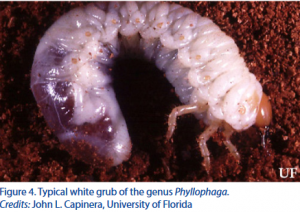 Larvae, called grubs, vary in length from ¾ to 1 ¾ inches depending on the stages. Grubs are white with a C-shaped body with a brown head and three pairs of legs near the head. Adults have ½ to 1 inch long, shiny bodies that are dark yellow to brownish-red in color. Adults do feed on the foliage of several species of ornamental plants, but the damage is typically only aesthetic; not causing long-term harm.
Larvae, called grubs, vary in length from ¾ to 1 ¾ inches depending on the stages. Grubs are white with a C-shaped body with a brown head and three pairs of legs near the head. Adults have ½ to 1 inch long, shiny bodies that are dark yellow to brownish-red in color. Adults do feed on the foliage of several species of ornamental plants, but the damage is typically only aesthetic; not causing long-term harm.
Monitoring of and managing emerging adults can help with deciding on the need for insecticide control for the grubs. To catch and remove adult beetles, place white buckets containing soapy water near plants that have chew marks or areas with lights at night. Leave it overnight. The beetles can easily be disposed of the next day. If there are more than 12 in the bucket be prepared to monitor the lawn for grubs. Extra rain or frequent irrigation during the adult flight time may attract more egg-laying females.
To inspect for grubs, turn over sod to a depth of at least two-inches. If there are an average of three or more per square foot, an insecticide treatment may be needed. To confirm that they are May/June beetles inspect the darkened rear of the grub. Locate the anal slit. It should be Y-shaped with two rows of parallel bristles that point toward each other. This is referred to as the raster pattern. All grub species can be identified using their unique “butt” features.
The most effective time to control this pest is summer or early fall when the larvae are small. Remove as much thatch as possible before applying an insecticide. Spot treat the off-colored area plus the surrounding 10 feet with products containing imidacloprid or halofenozide in early summer. Follow up in the fall with insecticides such as trichlorfon, bifenthrin or carbaryl if grubs persist.
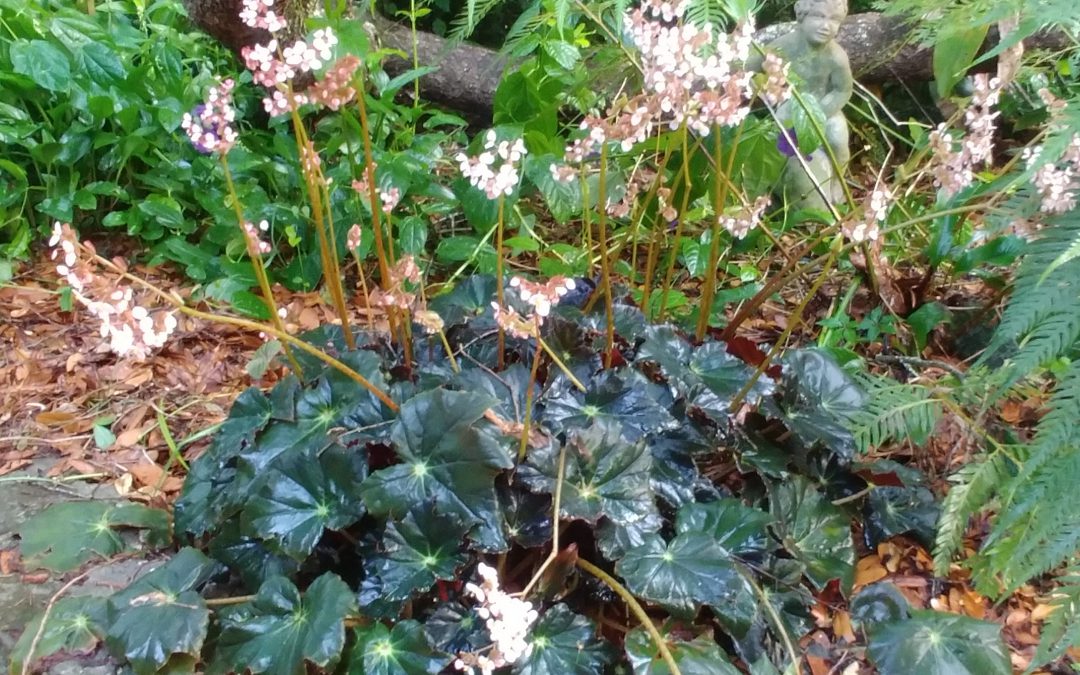
by Gary Knox | Apr 23, 2020
Article by Dr. Gary Knox, Professor of Environmental Horticulture at the UF/IFAS NFREC Quincy
Introduction
Rhizomatous begonias are a large group of Begonia species, hybrids and selections characterized by large, sometimes-colorful leaves arising from thick rhizomes that grow along the soil surface. White or pink flower clusters that appear in late winter and spring are an extra bonus with these plants. Some types can be used in north Florida as herbaceous perennials that add bold leaf texture and color as well as flowers to shady gardens.
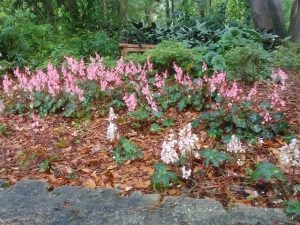
Begonia mass planting
Common rhizomatous begonias such as Begonia nelumbiifolia, ‘Erythrophylla’ (“Beefsteak”), and ‘Ricinifolia’ have long been grown outdoors in south and central Florida gardens as herbaceous perennials. North of these areas, rhizomatous begonias were considered cold sensitive and thus used strictly as pot-grown plants grown indoors or protected over winter. Nonetheless, north Florida trials testing the performance of outdoor, in-ground plantings started in Tallahassee and Gainesville as long ago as the late 1980s and early 1990s. With the proven success of some rhizomatous begonias in north Florida, interest in these plants increased rapidly in the early 2000s. Since then, savvy north Florida gardeners have been delighted by the possibility of using rhizomatous begonias as interesting herbaceous perennials for the shade garden. While temperatures below freezing can damage or kill leaves, these plants will usually produce new leaves from the rhizomes once warmer temperatures return in spring.
Plant Description Under North Florida Conditions
Leaves of rhizomatous begonias are this plant’s most distinctive feature and are why this group is so appealing to gardeners. Leaves often are large, from a few inches wide to almost 3 ft. in diameter (as reported for the cultivar ‘Freddie’ under the right conditions). Leaf shape may be rounded, star-shaped or irregularly edged, and leaf colors include burgundy, red, bronze, chartreuse, silver, and various shades of green including one so dark as to be almost black. Many types have leaves displaying patterns of one or more colors and some have silver or red markings. Undersides of leaves are often burgundy-colored, and leaf stems (petioles) also may exhibit colors other than or in addition to green. Leaves may be smooth, textured, or fuzzy-appearing due to large numbers of sometimes conspicuous hairs. Some types have leaves with an interesting three-dimensional spiral located on top of the leaf where the leaf blade attaches to the stem.
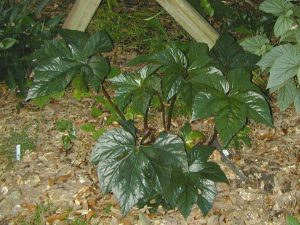
Begonia ‘Big Mac’ foliage
Rhizomatous begonia rhizomes are thickened, fleshy stems 1 to 2 in. or more in diameter that grow, branch and spread horizontally at or just below the soil surface, often in the mulch or leaf duff. Adventitious roots develop along the rhizome, and dormant buds embedded in the horizontal stem can be stimulated to grow new leaves after damage, stress or when divided. With age, as rhizomes grow outward, the oldest part of the rhizome will stop producing leaves and eventually die.
The rhizomes contain water and food reserves that allow this type of begonia to survive environmental stresses like drought as well as leaf loss or damage from cold temperatures. Shoots and roots can grow from the rhizome even if leaves and roots are killed or damaged.
Flowers occur in late winter to spring, depending on the species, cultivar and weather, and are quite showy on some selections. Flowers typically are white to various shades of pink and occur in a cluster (technically called a cyme) held above the foliage, in some cases dramatically high above the foliage. Individual flowers may range in size from 3/8-inch to over 2 inches at their widest point and a flower cluster may contain a few to over 120 individual flowers, depending on selection and growing conditions. A mature rhizomatous begonia may have an extended period of flowering, providing weeks of color. This long floral display results from large numbers of flowers developing sequentially on an individual flower cluster such that new flowers are still forming long after the first flowers have opened. Furthermore, multiple flower clusters appear over an extended time period. Flowers occasionally are pollinated and form winged seed capsules, though seed production and viability are variable. After flowering, the leaves remain a point of interest in the garden due to their size, lush appearance, interesting shapes and colorful patterns.
Cultural Requirements, Use and Maintenance
Rhizomatous begonias grow best in light shade or indirect light but can tolerate morning sun. Plants thrive in rich, organic, well-drained soil that is moist but not wet. A layer of organic mulch or leaf litter often is enough to provide basic conditions for growth in most soils if they are well-drained. Accordingly, organic mulches or leaf litter should be applied regularly around plants. Fertilizer stimulates growth but decomposing organic mulches can provide adequate nutrients, except perhaps with poor or sandy soils.
Newly planted begonias should be watered regularly. After establishment, most rhizomatous begonias benefit from regular watering but only require irrigation during periods of drought or extended dry weather.
An individual plant makes an attractive specimen plant in a container or in the garden. With time, a rhizomatous begonia can spread and, in the garden, develop into a patch. Alternatively, planting large numbers of the same rhizomatous begonia can create a very dramatic garden border, mass planting, or groundcover, especially in spring when all plants are flowering. To achieve this effect more rapidly and with smaller numbers of plants, tips of rhizomes can be pruned to stimulate rhizome branching and result in a denser plant or patch. Rhizome tip pruning should be done after plants finish flowering. Plants can be divided and moved easily since only the rhizome is needed to establish a new plant, but this should occur after flowering and early in the growing season so plants have long enough to establish before cold weather.
For aesthetic purposes, dead or damaged leaves may be removed as needed but especially after frosts and hard freezes. Similarly, leaves that overwinter often become “ratty” in appearance with time and may be removed without affecting plant growth.
Potential Problems
Rhizomatous begonias have few pests or other problems. Mealy bugs can occasionally infest plants. As with other large-leaved plants, wind or physical contact can tear and damage leaves. In north Florida, winter frosts and freezes can damage and disfigure leaves or kill leaves entirely, causing them to lose structural integrity and collapse, appearing mushy. Foliage may be protected during cold weather by frost cloth, sheets or other typical cold protection strategies, though heavy coverings could themselves damage leaves.
Rhizomes themselves usually survive cold weather because they are insulated from low temperatures by being half-buried in the ground and/or being covered by mulch. Adding mulch regularly to rhizomatous begonia plants will provide increased freeze-protection. Also, their typical planting location under tree canopies protects plants from a radiation freeze. Soil drainage is a more important factor for rhizomes since wet soil conditions could lead to rot, particularly in winter.
Common Types and their Descriptions Under North Florida Conditions
With hundreds of species and thousands of cultivars and hybrids, rhizomatous begonias can be overwhelming. Many rhizomatous begonias look alike and even experts have difficulty distinguishing species and cultivars. Many grown in north Florida have their origins in Mexico, Central and South America, though the Begonia Family is huge and species are found nearly world-wide.

Begonia heracleifolia
Technically rhizomatous begonias include Rex begonias, a group derived from Asian native, Begonia rex, and known for their especially colorful leaves. However, most Rex begonias do not grow well in Florida’s heat, high rainfall and high humidity, and so these begonias are excluded here.
Begonias listed below represent types that have proven resilient and usually cold hardy in north Florida USDA Cold Hardiness Zone 8b.
Species:
Begonia heracleifolia: The species boasts star-shaped leaves up to 6 in. across on stiff, hairy, thick leaf stems (petioles) up to 5 in. long. Each of the pointed leaf lobes is edged in dark green and has a chartreuse stripe along the central midrib, adding contrast. Spectacular sprays of pale pink flowers appear in late winter in clusters measuring 3 ½ in. by 4 ½ in. on 6-in. flower stalks (pedicels). Each cluster contains about 30 or more flowers, each about 1 in. across. As the season goes on, foliage gets showier and showier. It often dies down after winter freezes but re-emerges in late spring.
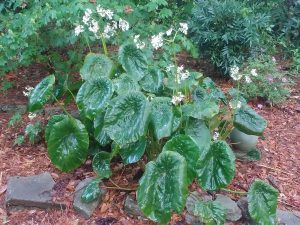
Begonia nelumbiifolia
- nelumbiifolia: This cold hardy begonia is known for its exceptionally large, water lotus-shaped leaves, creating a stunning specimen. Individual leaves can grow as large as 18 in. by 14 in. on leaf stems as long as 36 in. but 12 in. by 9 in. leaves are more typical. As temperatures warm, new developing foliage continues to get bigger, growing into very large leaves by fall. There also is a form in which the medium green leaves have red veining. White flowers are displayed above the foliage in mid to late spring in airy clusters measuring 7 ½ in. to more than 12 in. across on stems up to 48 in. tall. Clusters may contain as many as an astounding 120 flowers, each about ¾ in. across at its widest point.
2. popenoei: Huge rounded leaves with red veins and undersides make this a specimen plant which can grow to 3 ½ ft. tall and wide. Hardy with protection, it throws up tall stalks with clusters of white flowers in late winter.
Cultivars:
“Beefsteak”: This catch-all name refers to the original beefsteak begonia, ‘Erythrophylla’, as well as many derivatives that look similar. Beefsteak begonias characteristically have rounded leaves with a glossy green to bronze top surface and reddish undersides. Leaves range in size from 4 to 7 in. in diameter, and flower clusters are on stems up to 18 in. tall. ‘Erythrophylla’ was developed in 1847 and is considered a tough, vigorous plant, hence the common name, “beefsteak”. Given the long history and vigor, ‘Erythrophylla’ and derivative beefsteak begonias have long been shared as pass-along plants, world-wide as potted plants and later as an in-ground Florida garden plant. One type has ruddy, evergreen leaves and long-lasting, bold pink flower clusters. The scalloped 4-in leaves are on short 5 ½ in. reddish leaf stems but are most notable for remaining undamaged by temperatures down to the mid 20s °F, long after all other begonias’ leaves have turned to mush. Mid spring finds this plant topped by numerous clusters of dark pink flowers, with the display lasting 6 weeks or more. Individual clusters are about 8 in. by 5 in. on flower stems about 12 in. tall. Each cluster contains about 20 flowers each about ¾ in. wide at its widest point.

Begonia ‘Big Mac’ in flower
‘Big Mac’: This is a large, vigorous plant with enormous star-shaped leaves having reddish undertones and red leaf stems. The plant grows about 3 ft. tall and 2 ft. wide. Individual leaves may grow up to 18 in. wide on 16-in. leaf stems but typical leaves on younger plants are 10 in. to 12 in. wide. Individual white flowers are an amazing 2 in. wide at their widest point in clusters measuring 7 in. by 12 in. and containing about 75 flowers. Cold winters will knock it to the ground, but this begonia re-emerges again in late spring. This plant was hybridized in 1982 by Paul P. Lowe in Lake Park, Florida.
‘Joe Hayden’: This begonia features dramatic, dark, lobed leaves with burgundy undersides. Leaves are up to 8 in. long supported by leaf stems up to 9 in. long. In spring, the plant is topped by light pink flowers held high above the foliage. Each cluster measures about 5 in. by 7 in. on flower stems up to 26 in. tall. Each cluster contains more than 100 individual flowers, each about ¾ in. across at its widest point. This selection was hybridized in California in 1953 by Rudolf Ziesenhenne, but many similar selections have been made and are often confused with ‘Joe Hayden’.

Begonia ‘Joe Hayden’
Many other cultivars are common, but other cold hardy types suitable for north Florida include ‘Caribbean King’, ‘Caribbean Queen’, ‘Washington State’ and the catch-all ‘Ricinifolia’ types (with large, castor bean-shaped leaves). New breeding by scientists and enthusiasts promises to deliver many more types of rhizomatous begonias with increased foliage cold hardiness and an expanded range of foliage types and colors. A major Texas nursery introduced a series of rhizomatous begonia hybrids marketed as Crown Jewel Begonia™. The series currently features five patent-pending cultivars that are promoted as landscape plants for Zone 8. Additional breeding work is ongoing in north Florida.
Availability and Propagation
Rhizomatous begonias are available from Internet/mail order nurseries, some American Begonia Society members, other gardening groups, and plant societies. The introduction of trademarked rhizomatous begonias like Crown Jewel Begonia™ show promise for wider availability of rhizomatous begonias from nurseries.
Rhizomatous begonias are easily propagated by division, separation of rhizomes, or by rhizome pieces. When planting, place the rhizome or pieces (as small as 2 in. long) horizontally and half buried in a new in-ground location or in a container with potting soil. As with other begonia species, leaves may be used for propagation, though this method usually takes longer to achieve a size suitable for planting in the garden. Plants can be grown from seeds but production time is similarly long.
References:
American Begonia Society. (2020) https://www.begonias.org/index.htm. Accessed 15 April 2020.
Ginori, Julian, Heqiang Huo, and Caroline R. Warwick. (2020) A Beginner’s Guide to Begonias: Classification and Diversity, ENH1317. Environmental Horticulture Department, UF/IFAS Extension. January 2020. https://edis.ifas.ufl.edu/ep581.
Lowe, Paul. (1991) Growing Rhizomatous Begonias in the Ground in Southern Florida. Begonian 58:89. May/June 1991. https://www.begonias.org/Articles/Vol58/GrowingRhizomatousBegoniasFlorida.htm.
Schoellhorn, R. (2020) Personal communication, Alachua, FL.
Sharp, Peter G. (2011) Down to Earth – with begonias. 111 pp. http://ibegonias.filemakerstudio.com.au/PeterSharp/DownToEarthWithBegonias.pdf.
The International Database of the BEGONIACEAE. (2020) http://ibegonias.filemakerstudio.com.au/index.php?-link=Home. Accessed 16 April 2020.
UF/IFAS Gardening Solutions. (2019) Begonias. http://gardeningsolutions.ifas.ufl.edu/plants/ornamentals/begonias.html.
Watkins, Sue. (2020) Personal communication, Tallahassee, FL.

by Matt Lollar | Jan 13, 2020
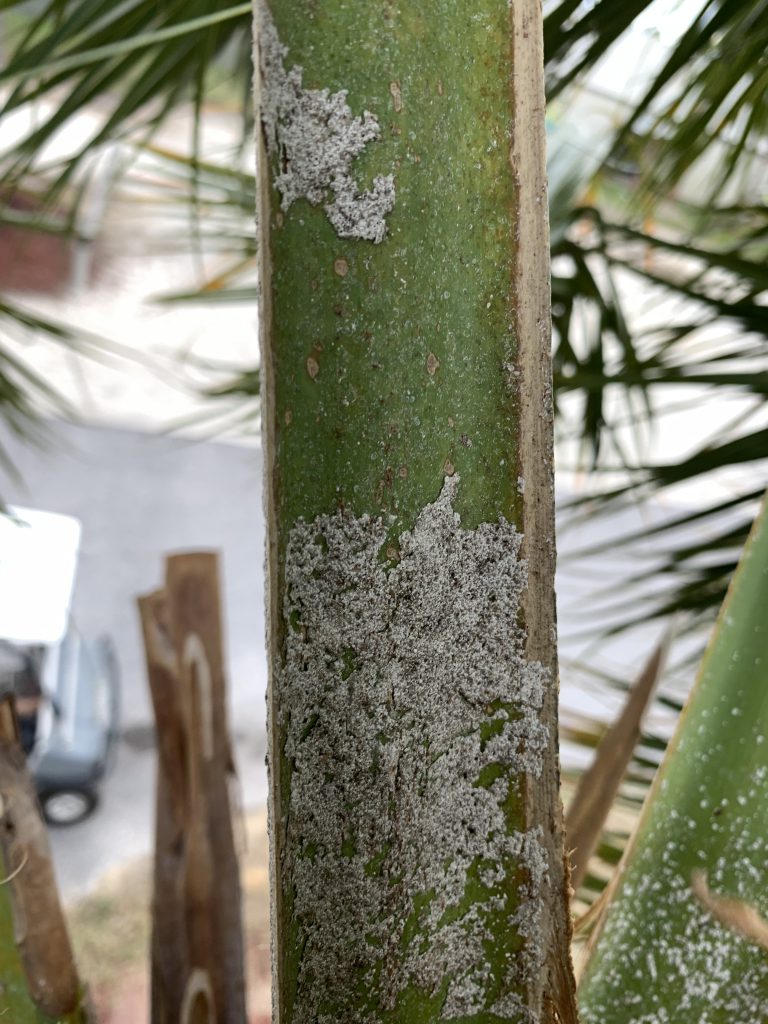
Scale insects on a cabbage palm (Sabal palmetto). Photo Credit: Matt Lollar, University of Florida/IFAS Extension – Santa Rosa County
This week I was on a couple site visits to look on some cabbage palms (Sabal palmetto) and some banana shrubs (Michelia figo). The palms had a white, waxy substance on their frond petioles and the banana shrubs had white specs on the tops of their leaves. Upon further investigation, I realized the waxy substance and specs were both different species of scales. Scale insects are serious pests of a number of ornamental plants. Here in Florida there are 13 different families of scales with the most common being armored scales, soft scales, and mealybugs. Scales have piercing-sucking mouthparts which they use to siphon fluids from the leaves, stems, and sometimes roots of many ornamental plants. Heavy infestations cause extensive leaf yellowing, premature leaf drop, branch dieback, and eventually plant death.
Scale Biology
The life cycle of a scale begins with eggs being laid beneath wax coverings or beneath the adult female. Eggs typically hatch in 1 to 3 weeks. The newly hatched nymphs, called crawlers, move around a plant until they find a spot to feed. Once a feeding site is located, their piercing sucking mouthparts are inserted into the plant and the crawlers begin to feed and grow. The males of many scale species develop wings as adults and fly to other plants to reproduce.

Magnolia white scales on a banana shrub (Michelia figo). Photo Credit: Matt Lollar, University of Florida/IFAS Extension – Santa Rosa County
Armored Scales
Armored scales get their armor by secreting a waxy covering over their bodies that is not attached. The scale lives under this covering and uses it as a protection to feed under. Armored scales can be almost any color or shape and range anywhere from 1/16 to 1/8 inch in diameter. For females, these shapes range from circular to oval to long and slender. The males typically have coverings that are more elongate and smaller than the females. As adults, the males are tiny, winged, gnat-like insects and are rarely seen.
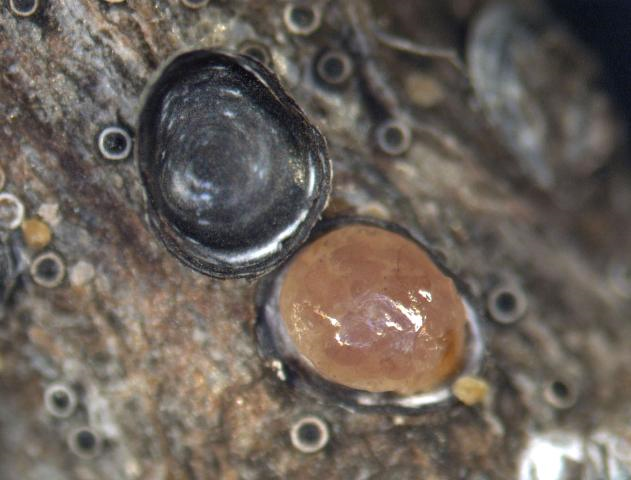
Gloomy scale (Melanaspis tenebricosa) with armored covering removed. Photo Credit: A. G. Dale, University of Florida/IFAS
Soft Scales
Similar to armored scales, soft scales secrete a waxy covering, but it is attached to their bodies. Soft scales can be a number of colors, shapes, and sizes and range anywhere from 1/8 to 1/2 inch in diameter. Their shapes vary from spherical to nearly flat.

Population of adult and immature tuttle mealybugs (Brevennia rehi) on a blade of zoysiagrass. Photo Credit: Lyle J. Buss, University of Florida/IFAS
Mealybugs
Mealybugs are soft-bodied insects that possess a covering of flocculent, white, waxy filaments. They are about 1/8 inch in length and usually pinkish or yellowish in color. Mealybugs have piercing-sucking mouthparts which they use to siphon fluids from the leaves, stems, and sometimes roots of many ornamental plants. Mealybug damage produces discolored, wilted, and deformed leaves.
Scale and Mealybug Management
- Cultural Control – Plant inspection prior to purchase or installation is the first line of defense against a scale or mealybug population. Make sure to inspect the undersides of leaves and plant stems. Infested sections of plants can be pruned and plant material should be cleaned from the planting area and discarded. Also, you can increase air flow and decrease humidity by proper installation and pruning. Over-fertilizing can also increase pest populations.

Larva of a brown lacewing. Credits: Lyle Buss, University of Florida.
- Biological Control – Predators, such as ladybugs and green lacewings, are usually present in large enough numbers to suppress scales and mealybugs to a desirable threshold. However, broad-spectrum insecticides and bad weather can reduce predator numbers. Look for signs of predation by inspecting dead scales for jagged holes in their waxy coatings. If predation signs are present, use more selective chemical controls and oils as opposed to broad-spectrum products.
- Chemical Control – Timing is everything when it comes to managing scale and mealybug insects. Crawler activity is more pronounced with the flush of new plant growth in the spring. Before application, prune infested plant parts off first to promote greater penetration of insecticides into the foliage. Dormant Oils are often used in the winter to smother scale insects. These are good choices to implement because they don’t harm non-target or beneficial insects. Care must be taken to read the label and use them at the correct temperature, since use in hot weather may burn foliage. Contact products (acephate, bifenthrin, carbaryl, etc.) must be applied to inhibit the crawler stages of these insects and systemic products (acetamiprid, imidacloprid, thiamethoxam, etc.) can be used on the sessile growth stage. Plants should be sprayed thoroughly to the point of drip or “run off” from leaves, twigs, and stems. Repeated applications may still be necessary even if the timing is right, as crawler populations are often large and crawlers like to hide under old waxy scales. Systemic drenches are also a viable option. With good spray coverage, horticultural oils can kill scales at all stages of growth. Refer to the product label for phytotoxicity and temperature guidelines. Even after successful treatment, the outer coatings of the scales may remain on the plant material for weeks, which can be unsightly. The best way to determine if scales are dead is to squeeze them. They will be dry when squeezed if they are dead and they will ooze liquids if they are living (they were at least alive to the point of being squashed).
For insect identification and additional information on scale control, please see:
A Guide to Scale Insect Identification
UF/IFAS Featured Creatures
Your County Extension Office





